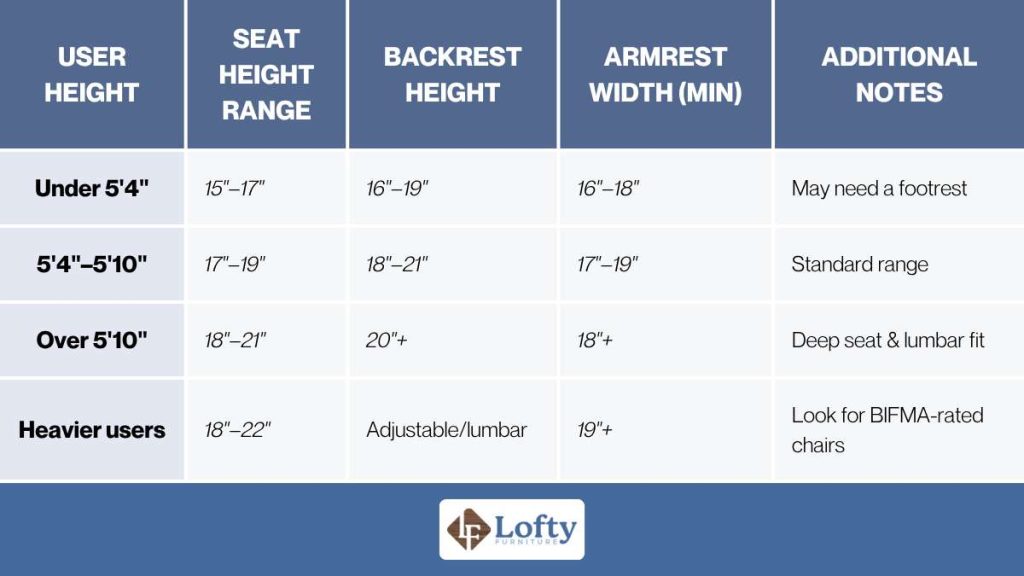Did you know that the average office worker spends about 10 hours a day sitting at their desk? That is a staggering amount of time spent in one position, and it can have serious implications for your health and well-being. In this era of modern work, understanding the best way to sit on an office chair is more critical than ever.
Key Takeaways:
- The best way to sit on an office chair involves maintaining a neutral spine position, with feet flat on the floor and knees forming a 90-degree angle. Adjust the chair height so that your elbows are at desk level.
- Take breaks to stand, and don’t forget to stretch regularly.
- To choose the right office chair for extended sitting, prioritize adjustability, lumbar support, seat depth and width, and good material.
Understanding the features of your chair is essential for maintaining good posture throughout the day. In this article, we will guide you through the best way to sit on your office chair to ensure optimal comfort and support.
Understanding Your Chair: Essential Features for Optimal Support
To get the most out of your office chair, make sure it has essential features like adjustable lumbar support and a flexible backrest that molds to your body shape. Chair adjustments play a crucial role in providing optimal support and comfort throughout the day.
Here are the different ergonomic chairs and the key features you should look out for:
Start by adjusting the seat depth to ensure that your thighs are fully supported while maintaining a slight gap between the edge of the seat and the back of your knees for proper circulation.
Next, focus on lumbar support. Adjust the height and depth of the lumbar support to maintain a natural curve in your lower back. This helps alleviate pressure on your spine and promote good posture.
Additionally, check if your chair offers armrest position adjustments. Position them at a height where your arms can rest comfortably while keeping them close to your body.
Consider headrest options as well, especially if you spend long hours working at a desk. A headrest offers much-needed neck support and can lessen the strain from prolonged sitting.
By understanding these essential features and making the necessary adjustments, you will create an ergonomic seating setup that supports both your physical well-being and productivity throughout the workday. Remember, investing in an office chair with these features is essential for promoting comfort and reducing fatigue or pain associated with prolonged sitting.
If you are still unsure which chair to get for your office, you might want to read more about standing desks and ergonomic chairs.
The Correct Way to Sit Up Straight on an Office Chair
Slouching is a definite no-no if you want to maintain good posture throughout the day. The correct way to sit up straight involves several key elements:
- Proper alignment
- Core engagement
- Lumbar support
- Shoulder positioning
- Neck and head alignment
Firstly, proper alignment is essential for maintaining good posture. Make sure your feet are flat on the floor with your knees at a 90-degree angle. Your hips should be pushed back into the chair, aligning with your knees.
Next, engage your core muscles by gently pulling your belly button towards your spine. This helps to support your lower back and keeps you sitting upright. Adjust the lumbar support of your office chair so that it fits snugly against the curve of your lower back.
Proper shoulder positioning involves rolling them back and down, away from your ears. This helps to open up your chest and relieve tension in the shoulders.
Lastly, ensure that your neck and head are aligned with the rest of your spine. Avoid jutting forward or tilting sideways, as this can lead to strain on the neck muscles.
By following these guidelines for sitting up straight, you will promote proper posture and reduce the danger and discomfort associated with prolonged sitting at work. Remember to take regular breaks and stretch throughout the day to further support a healthy body position.
Ergonomics by Body Type: Customizing Posture for Height, Weight, and Build
General posture tips are a good starting point, but tweaking your chair setup to fit your height, weight, and body shape makes a big difference in comfort and support. Taller folks usually need higher seats and deeper backs, while shorter people might want footrests to keep their legs from hanging. If you have broad shoulders, wider armrests help, and heavier users should look for stronger chairs with bigger seats.
You can use the ergonomic ranges below as a guide to adjust your chair so it fits you just right.

Maintaining Good Posture: Regular Checks and Adjustments
Maintaining good posture means regularly checking and adjusting how you’re sitting to avoid slipping into the typical office chair slump. Good posture isn’t just about comfort; it helps prevent back pain, boosts energy levels, and supports your overall well-being and productivity. Throughout the day, take a moment to check your setup: your feet should be flat on the floor (or on a footrest if needed), and your knees should be at a 90-degree angle, level with or just below your hips to keep pressure off your lower back.
Make sure your back is supported by your chair’s lumbar support or a cushion, and sit upright with relaxed shoulders—no slouching or leaning forward. Your arms should also be at a 90-degree angle while typing, with wrists in a neutral position to reduce strain. These small adjustments can make a big difference over time. And don’t skip those hourly stretch breaks; they help loosen tight muscles, improve circulation, and keep you feeling refreshed throughout the day.
Movements and Breaks
To stay energized and avoid discomfort during your workday, make it a point to take regular movement and stretch breaks. Sitting for long periods can cause stiffness and fatigue, especially in areas like your neck, shoulders, and wrists. Simple stretches, like shoulder rolls, neck rotations, and wrist flexions,can go a long way in relieving tension and keeping your body flexible. These small movement breaks not only help maintain good posture but also support your overall well-being while working at a desk.
It’s also worth adding ergonomic tools to your setup for extra support. A lumbar pillow can help keep the natural curve of your lower back, while a standing desk gives you the option to switch between sitting and standing throughout the day, great for reducing the strain of staying in one position too long. On top of that, try incorporating posture-focused exercises like planks, wall sits, or bridges into your routine. These strengthen your core and help your body stay aligned, even during long hours at your desk.
Tips for Better Comfort and Posture
Take your comfort and posture to the next level with these advanced tips that will revolutionize your workday. Achieving enhanced comfort is crucial for a productive and comfortable working environment.

1. Dynamic Sitting: Consider a chair with a dynamic sitting feature, an example of which is a kneeling chair, that allows you to move while sitting. This promotes micro-movements and engages different muscles, preventing stiffness and promoting better circulation.
2. Active Sitting Tools: Explore tools like stability balls or active sitting chairs that engage your core muscles. These alternatives encourage better posture and can help prevent back pain and bad hips by promoting movement while sitting.
3. Posture Monitoring Devices: Invest in a wearable or desk-mounted device that monitors your posture. These devices can provide real-time feedback, reminding you to maintain proper posture throughout the day.
4. Sit-Stand Desk: Combine your ergonomic chair with a sit-stand desk or an ergonomic stand-up desk. Alternating between sitting and standing throughout the day can reduce the risk of musculoskeletal issues and increase overall comfort.
5. Ergonomic Accessories: Consider ergonomic office accessories such as a footrest, which can help maintain proper leg and hip alignment. Additionally, a keyboard and mouse tray that can be adjusted to the optimal height can enhance comfort and reduce strain.
6. Heat and Massage Features: Some advanced office chairs come with built-in heat and massage features. These can help relax muscles, improve circulation, and contribute to overall comfort during extended periods of sitting.
7. Environmental Ergonomics: Pay attention to the overall office setup. The best way to sit at a desk is to ensure that your computer monitor is at eye level and your keyboard and mouse are easily accessible. An ergonomically optimized workspace complements the benefits of a good chair.
8. Mindful Breaks and Stretching: Implement a routine of mindful breaks and stretching exercises. This can include standing up, stretching, and performing simple exercises to counteract the effects of prolonged sitting on your muscles and joints.
9. Customizable Ergonomics: Look for chairs that offer advanced customization options, such as adjustable tension control for reclining, multiple tilt angles, and individual adjustments for different parts of the chair to tailor the support to your unique body shape and preferences.
10. Professional Ergonomic Assessment: Consider consulting with an ergonomics professional for a personalized assessment of your workspace and chair setup. They can provide specific recommendations based on your body mechanics, work habits, and any existing health concerns.
11. Balance Between Support and Freedom: Find the right balance between support and freedom of movement. Your chair should provide adequate support for proper posture while allowing you to move comfortably and adjust your position throughout the day. This balance becomes especially important during pregnancy, when posture needs often change. Knowing how to sit in an office chair during pregnancy. can help reduce lower back pressure, support your spine, and improve overall comfort during long hours at a desk.
As a guide, here’s how you should organize your ideal or standard desk for maximum ergonomics:
How To Choose the Right Office Chair for Extended Sitting
Choosing the right office chair for extended sitting is crucial for your comfort, productivity, and overall well-being. Here are some factors to consider when selecting an office chair:
Adjustability
- Look for an easily adjustable chair. Key adjustable features include seat height, armrest height, backrest tilt, and lumbar support.
- The ability to customize the chair to your body proportions ensures proper alignment and reduces the risk of discomfort or pain.
Lumbar Support
- Look for a chair with adjustable lumbar support to provide adequate support for your lower back.
- The lumbar support should be adjustable both in height and depth to accommodate different body types.
Seat Depth and Width
- Choose a chair with an adjustable seat depth or one that fits the natural length of your thighs. Ideally, you should be able to sit with your back against the backrest and have 2-4 inches between the back of your knees and the chair seat.
- Ensure the seat width is appropriate for your body size. A seat that is too narrow or too wide can lead to discomfort. If you’re on the taller side, you may want to explore office chairs for tall people designed with longer seat depth, higher backrests, and enhanced legroom to better support your posture and comfort during long hours of sitting.
Material and Padding
- Consider the material of the chair and the padding used. Breathable and durable materials are essential for comfort during long periods of sitting.
- The seat should have enough padding to provide comfort without being too soft, as this may lead to poor posture.
Armrests
- Armrests should be at a height where your shoulders are relaxed and your forearms are parallel to the ground when resting on them.
- Some chairs offer armrests that can be adjusted in terms of height, width, and angle.
Swivel and Casters
- A chair that swivels easily allows you to reach different areas of your desk without straining.
- Choose a chair with smooth-rolling casters suitable for your floor type. This ensures easy movement without causing damage to the floor surface.
Tilt Mechanism
- A chair with a reclining or tilting mechanism can help relieve pressure on your spine and promote good posture.
- Look for a chair that allows you to lock the tilt in different positions.
Budget
- While it is important to invest in a quality chair, consider your budget.
- There are ergonomic chairs available at various price points, so find one that meets your needs without breaking the bank.
Try Before You Buy
- Whenever possible, try out the chair before purchasing. Sit in it for an extended period to ensure it remains comfortable over time.
User Reviews
- Read user reviews and testimonials to get an idea of how well the chair has performed for others in real-world scenarios.
Common Posture Mistakes Office Workers Make (and How to Fix Them)

Even with the right chair and workstation setup, many office workers fall into poor posture habits that can lead to discomfort or chronic pain over time. One of the most common mistakes is slouching or rounding the shoulders, often caused by leaning toward the screen or using a laptop without proper elevation. Another frequent error is sitting too far forward on the seat pan, which removes the support of the backrest and increases pressure on the lower spine.
To correct these issues, start by retraining your sitting habits through conscious posture checks and small physical adjustments. Sit with your hips fully back in the seat, and ensure your back maintains contact with the lumbar support. Keep your screen at eye level and your elbows at roughly 90 degrees to reduce shoulder strain. Use a footrest if your feet don’t rest flat on the floor, and avoid crossing your legs, which can cause asymmetry in the pelvis. Small corrections can go a long way in preventing long-term discomfort.
Sit Smart: Your Blueprint for Better Posture
Now you have mastered the art of sitting on an office chair like a pro. By understanding your chair’s essential features, choosing the right one for extended sitting, and maintaining good posture, you have unlocked a world of comfort and productivity.
Remember to take regular breaks and move around to keep those creative juices flowing. With these advanced tips and desk ergonomics in your arsenal, you are ready to conquer any workday with grace and ease.
Frequently Asked Questions (FAQs)
How do I know if my office chair is properly adjusted?
Your chair is properly adjusted when your feet rest flat on the floor or a footrest, knees form about a 90-degree angle, and there’s a small gap between the seat edge and your calves. Your hips should sit slightly higher than your knees, and the backrest should support the natural curve of your lower back.
What are the signs of poor sitting posture?
Poor posture often shows up as aches in your neck, shoulders, and lower back that worsen during the day. You might also notice your head leaning forward, rounded shoulders, or a hunched upper back.
How long does it take to correct bad posture habits?
Fixing bad posture depends on how long you’ve had the habit and how consistent you are with corrections. You might feel some relief in a couple of weeks, but real, lasting changes usually take 2 to 6 months.
What’s the best posture for working with dual monitors?
If you use both monitors equally, place them side by side, angled slightly inward like a gentle “V,” centered in front of you. If one is primary, put that one directly in front and the secondary just to the side, both with the top edges at or just below eye level and about an arm’s length away.
